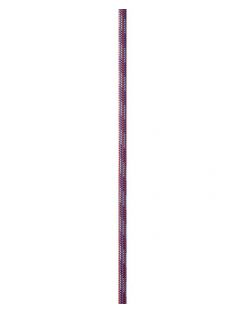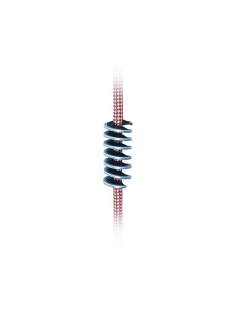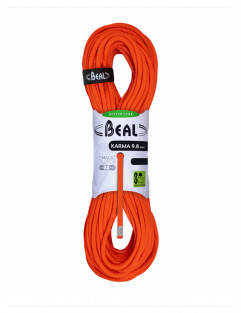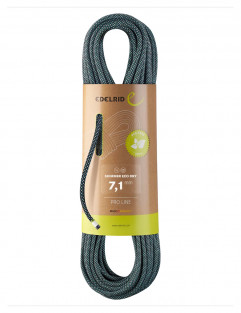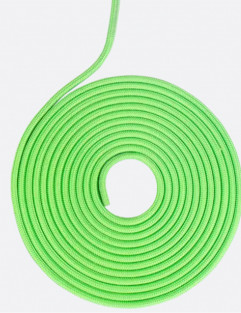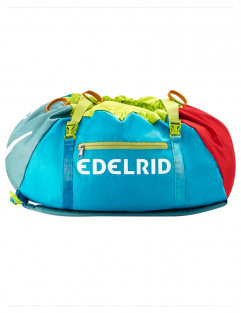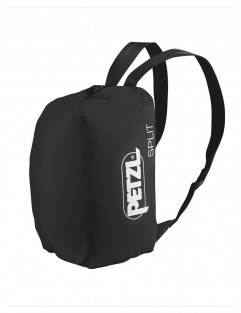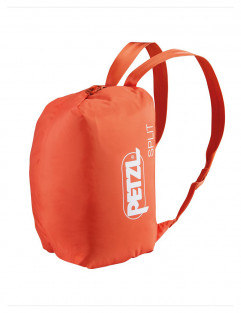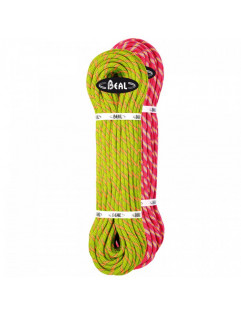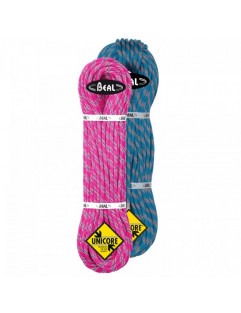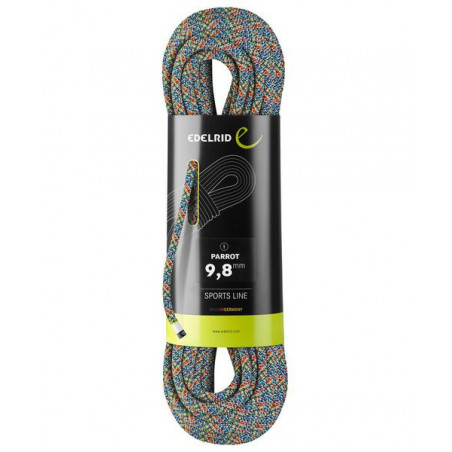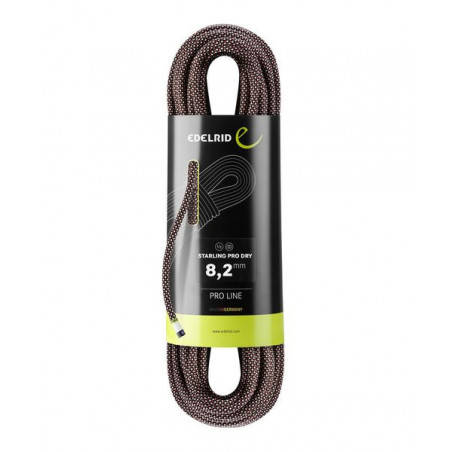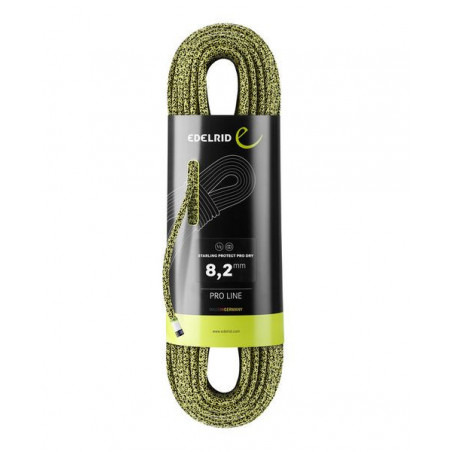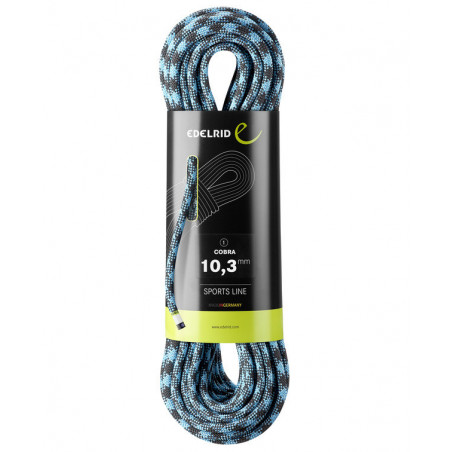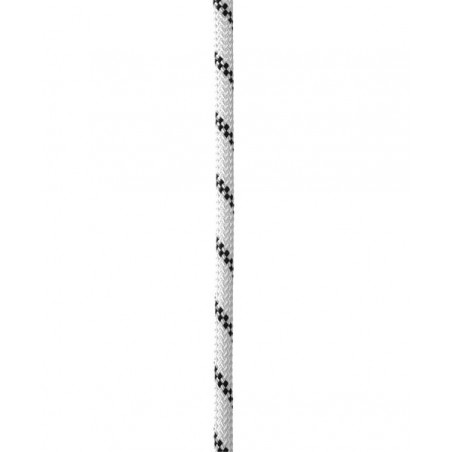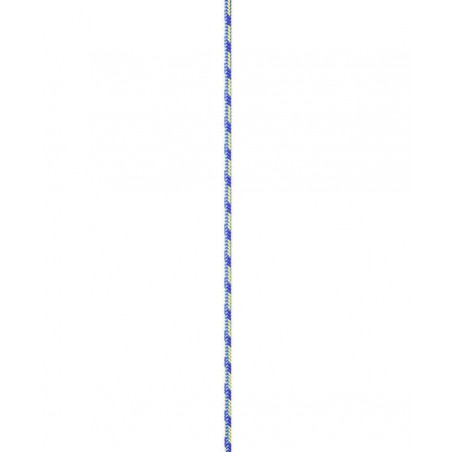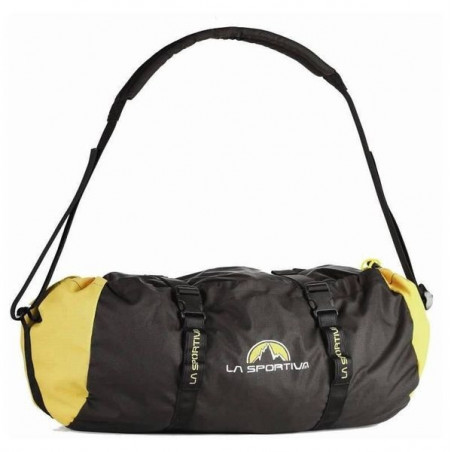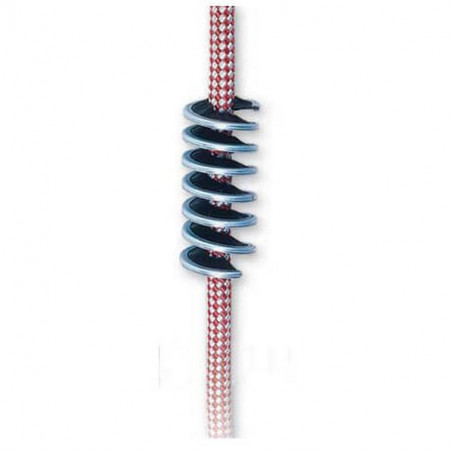New products
Active filters
accessory-cords
Edelrid - Powerloc Expert SP 8 mm - Oasis/Flame - 1 mrope-care
Beal - Rope Brushrope-care
Beal - Rope Cleaner - 1 Lactivities
Beal - Karma - 9,8 mm - Solid Orange - Climbing Ropealpine-ropes
Edelrid - Skimmer Eco Dry 7,1 mm - Night - Mountaineering...accessory-cords
Edelrid - Powerloc Expert SP 4 mm - Aqua/Oasis - 1 maccessory-cords
Edelrid - Hard Line - 6 mm - Neon Green - Accessory Cordtwin-ropes
Beal - Legend 8,3 mm Pack - Green/Pink - Climbing Ropesactivities
Beal - Cobra II 8,6 mm Pack - Golden Dry - Blue/Fuchsia -...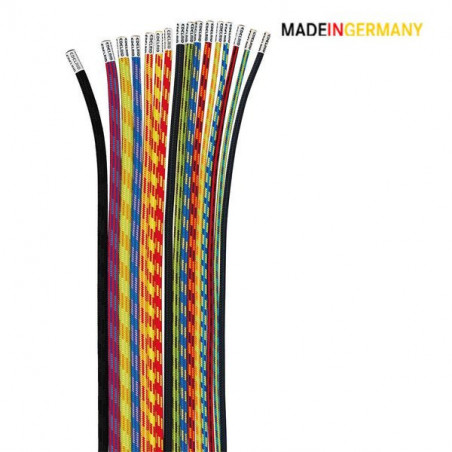
Ropes
How to choose a climbing rope?
When going out to by a climbing rope there are four main features to consider:
- What type of rope do you need?
- What diameter and length should the rope have?
- What features should the rope provide?
- What safety certification should the rope have?
All of these entirely depend on what you need the rope for? Are you going mountaineering? Indoor climbing? Multi-pitch? Etc.
Type of rope
There are three main differences in rope types designed for climbing: single, half, and twin ropes. Furthermore, a difference is made between static and dynamic ropes. In climbing, static ropes are only used when lowering an injured climber or ascending a rope. They are not designed, certified or tested to climb on because they stretch very little, that's what dynamic ropes are made for.
Single Ropes:
Most people tend to buy single ropes because they come in many different diameters and lengths, making them super versatile in their use. A single rope is a rope that is not to be used in combination with any other rope but by itself, like the name suggests. It's important to only use a rope as it was designed and tested to be used. Some single ropes can be used as twin or half rope too if this is specified by the manufacturer.
Single ropes are marked with a circled 1 on each end of the rope.
Single ropes, like previously mentioned are very versatile, and tend to be best for trad climbing, sport climbing, big-wall climbing and top roping.
Half Ropes:
When using half ropes, you climb with two ropes. As you ascend, clip one rope to protection on the left and the other to protection on the right. This allows the ropes to run parallel and straight, thereby reducing rope drag on wandering routes. Half ropes are ideal for trad climbing on wandering multi-pitch rock routes, mountaineering and ice climbing. They do have their positive and negative sides. What is good about them is the reduced rope drag on wandering routes; two ropes can rappelle further than 1 rope; if one rope gets damaged you still have a second one. The downside to this style is first of all more weight, since you are carrying two ropes; and the handling of 2 half ropes is harder than that of a single rope. It's important to only use a rope the way it was designed and tested to be used.
Half ropes are marked with a circled ½ symbol on each end.
Half ropes are best for trad climbing on wandering multi-pitch rock routes, mountaineering and ice climbing.
Twin Ropes:
Just like half ropes, twin ropes require a two-rope system. Twin ropes however have more drag due to the fact that you always have to clip both strands through each piece of protection, just like you would on a single rope. This component makes the twin-rope system ideal for non-wondering routes. Furthermore, compared to half ropes, twin ropes tend to be lighter because they are a bit thinner. As for the advantages and disadvantages of this system compared to a single rope they are the same as for a half rope. On one hand, two ropes can rappelle further than 1 rope and if one rope gets damaged you still have a second one. On the other hand, two ropes are heavier than one and working with two ropes is more complicated than with one. Just as with half ropes, twin ropes are designed and tested only for use as a matching pair; don’t mix sizes or brands.
Twin ropes have a circled infinity symbol (∞) on each end.
Twin ropes are best for trad climbing on non-wandering multi-pitch rock routes, mountaineering and ice climbing.
Static Ropes:
They are not meant for sports climbing but rather for rescue work, caving, climbing fixed lines with ascenders and hauling loads. Static ropes are amazing when you are in a situation where you do not want the rope to stretch, like when injured climber needs to be lowered, hauling equipment up wit a rope or when ascending a rope.
Climbing rope diameter:
The rope diameter of a rope can vary quiet a bit and can make a huge difference on your climbing experience. Thinner ropes for example have the advantage of being lighter than thicker ropes but at the same time they are not as robust and need more skill when belaying with them. So depending on wether you are top roping in your local gym/crag or going for long distance multi-pitches you'll want something completely different.
Static ropes have a diameter of about 9-13 mm.
Half ropes have a diameter of about 8-9 mm.
Twin ropes have a diameter of about 7-8 mm.
Single ropes have more uses to them so the sizes vary a bit more:
up to 9.4 mm are ideal for long multi-pitches due to their reduced weight.
9.5 - 9.9 mm are good allrounders, they are light enough for a trip to the mountains and yet robust enough for repeated indoor use
10 mm and above are ideal to use in the gym, when figuring out the moves and making repeated falls
Rope length:
In sports climbing the average rope length is about 60m but the range goes from 30m-80m for a single rope. The only thing you need to "watch out" for is that the rope is at least twice as long as the route you are attempting because you obviously have to get back down. Generally indoor ropes are no longer than 40m since the routes are generally quiet short (15m) compared to outdoor routes (30m) where you could need up to 80m.
Rope features:
When comparing ropes these are some features to look for:
- Dry treatment is designed to reduce the ropes water absorption. While a rope is wet it becomes less resistant to falls, and if it should freeze, the rope becomes very hard to handle. Dry treatment is important should you plan on ice climbing for example.
- Middle Mark is a black dye mark half way of the rope to indicate that you have half of the length left.
- End warning marks are shown on some ropes when approaching the end of the rope
Safety:
The Union Internationale des Associations d'Alpinisme (UIAA) is the international mountaineering and climbing federation that creates safety standards to which all climbing ropes must adhere. These are the criteria that make a climbing rope fit for sports use.
The Fall rating is determined to identify how many falls a rope can take before failing. This is being determined differently for different rope types. All single ropes and half ropes must withstand a minimum of 5 UIAA falls. Twin ropes must withstand a minimum of 12 UIAA falls. This might not seem like a lot but the falls in the tests are much greater than in actual climbing.
Static elongation, is the amount a dynamic rope stretches with an 80kg attached to it. In general the elongation on single and twin ropes can't be more than 10% of total rope length and half ropes 12%
Dynamic elongation is the distance the rope stretches during the first UIAA fall and cannot exceed 40% of total rope length.
The choices are endless and difficult today so contact our Customer Service or send us a mail to help you choose the right product for your needs.
Shop online.........more time to climb.
Casper's Supports Your Summit
Subcategories
-
Single Ropes
<h2 class="cdr-my-space-one-x cdr-text cdr-text--heading-serif-800@xs cdr-text--heading-serif-strong-900">How to choose a climbing rope?</h2> <p>When going out to buy a climbing rope there are four main features to consider:</p> <p>- What type of rope do you need?</p> <p>- What diameter and length should the rope have?</p> <p>- What features should the rope provide?</p> <p>- What safety certification should the rope have?</p> <p>All of these entirely depend on what you need the rope for? Are you going mountaineering? Indoor climbing? Multi-pitch? Etc.</p> <h3><span>Type of rope</span></h3> <p>There are three main differences in rope types designed for climbing: single, half, and twin ropes. Furthermore, a difference is made between static and dynamic ropes. In climbing, static ropes are only used when lowering an injured climber or ascending a rope. They are not designed, certified or tested to climb on because they stretch very little, that's what dynamic ropes are made for. </p> <p><strong>Single Ropes:</strong></p> <p>Most people tend to buy single ropes because they come in many different diameters and lengths, making them super versatile in their use. A single rope is a rope that is not to be used in combination with any other rope but by itself, like the name suggests. It's important to only use a rope as it was designed and tested to be used. Some single ropes can be used as twin or half rope too if this is specified by the manufacturer.</p> <p>Single ropes are marked with a circled 1 on each end of the rope.</p> <p>Single ropes, like previously mentioned are very versatile, and tend to be best for trad climbing, sport climbing, big-wall climbing and top roping.</p> <p><img src="https://caspersclimbingshop.com/img/cms/swift89mm.jpeg" alt="" width="400" height="400" /></p> <p><a href="https://www.caspersclimbingshop.com/single-ropes/1855-swift89mm.html?search_query=single+rope&results=26" target="_blank" class="btn btn-default" rel="noreferrer noopener">Edelrid - Swift 8,9mm Single rope</a></p> <h3><span>Climbing rope diameter:</span></h3> <p>The rope diameter of a rope can vary quiet a bit and can make a huge difference on your climbing experience. Thinner ropes for example have the advantage of being lighter than thicker ropes but at the same time they are not as robust and need more skill when belaying with them. So depending on wether you are top roping in your local gym/crag or going for long distance multi-pitches you'll want something completely different.</p> <p><strong>Single ropes </strong>have more uses to them so the sizes vary a bit more:</p> <blockquote> <p><em>up to 9.4 mm </em>are ideal for long multi-pitches due to their reduced weight.</p> <p><em>9.5 - 9.9 mm </em>are good allrounders, they are light enough for a trip to the mountains and yet robust enough for repeated indoor use</p> <p><em>10 mm and above </em>are ideal to use in the gym, when figuring out the moves and making repeated falls</p> <p></p> <h3>Rope features:</h3> </blockquote> <p>When comparing ropes these are some features to look for:</p> <ul> <li><strong>Dry treatment </strong>is designed to reduce the ropes water absorption. While a rope is wet it becomes less resistant to falls, and if it should freeze, the rope becomes very hard to handle. Dry treatment is important should you plan on ice climbing for example. </li> <li><strong>Middle Mark </strong>is a black dye mark half way of the rope to indicate that you have half of the length left.</li> <li><strong>End warning marks </strong>are shown on some ropes when approaching the end of the rope</li> </ul> <p></p> <p>The choices are endless and difficult today so contact our <a href="/contact-us">Customer Service</a> or <a href="mailto:info@caspersclimbingshop.com">send us a mail</a> to help you choose the right product for your needs. </p> <p></p> <p>Shop online.........more time to climb.</p> <p></p> <p>Casper's Supports Your Summit</p> -
Half Ropes
<h1 class="cdr-my-space-one-x cdr-text cdr-text--heading-serif-800@xs cdr-text--heading-serif-strong-900"><span style="text-decoration:underline;">Half ropes</span></h1> <h2 class="cdr-my-space-one-x cdr-text cdr-text--heading-serif-800@xs cdr-text--heading-serif-strong-900">How to choose a climbing rope?</h2> <p>When going out to buy a climbing rope there are four main features to consider:</p> <p>- What type of rope do you need?</p> <p>- What diameter and length should the rope have?</p> <p>- What features should the rope provide?</p> <p>- What safety certification should the rope have?</p> <p>All of these entirely depend on what you need the rope for? Are you going mountaineering? Indoor climbing? Multi-pitch? Etc.</p> <p></p> <h3><span>Type of rope</span></h3> <p>There are three main differences in rope types designed for climbing: single, half, and twin ropes. Furthermore, a difference is made between static and dynamic ropes. In climbing, static ropes are only used when lowering an injured climber or ascending a rope. They are not designed, certified or tested to climb on because they stretch very little, that's what dynamic ropes are made for.</p> <p><strong>Half Ropes:</strong></p> <p>When using half ropes, you climb with two ropes. As you ascend, clip one rope to protection on the left and the other to protection on the right. This allows the ropes to run parallel and straight, thereby reducing rope drag on wandering routes. Half ropes are ideal for trad climbing on wandering multi-pitch rock routes, mountaineering and ice climbing. They do have their positive and negative sides. What is good about them is the reduced rope drag on wandering routes; two ropes can rappelle further than 1 rope; if one rope gets damaged you still have a second one. The downside to this style is first of all more weight, since you are carrying two ropes; and the handling of 2 half ropes is harder than that of a single rope. It's important to only use a rope the way it was designed and tested to be used.</p> <p>Half ropes are marked with a circled ½ symbol on each end.</p> <p>Half ropes are best for trad climbing on wandering multi-pitch rock routes, mountaineering and ice climbing.</p> <p><img src="https://caspersclimbingshop.com/img/cms/paso.jpeg" alt="" width="400" height="400" /><img src="https://caspersclimbingshop.com/img/cms/paso2.jpeg" alt="" width="400" height="400" /></p> <p><a href="https://www.caspersclimbingshop.com/twin-ropes/1944-paso.html?search_query=paso&results=1" target="_blank" class="btn btn-default" rel="noreferrer noopener">Petzl Paso Half Ropes</a></p> <h3><span>Climbing rope diameter:</span></h3> <p>The rope diameter of a rope can vary quiet a bit and can make a huge difference on your climbing experience. Thinner ropes for example have the advantage of being lighter than thicker ropes but at the same time they are not as robust and need more skill when belaying with them. So depending on wether you are top roping in your local gym/crag or going for long distance multi-pitches you'll want something completely different.</p> <p><strong>Half ropes </strong>have a diameter of about 8-9 mm.</p> <h3><span>Rope features:</span></h3> <p>When comparing ropes these are some features to look for:</p> <ul> <li><strong>Dry treatment </strong>is designed to reduce the ropes water absorption. While a rope is wet it becomes less resistant to falls, and if it should freeze, the rope becomes very hard to handle. Dry treatment is important should you plan on ice climbing for example. </li> <li><strong>Middle Mark </strong>is a black dye mark half way of the rope to indicate that you have half of the length left.</li> <li><strong>End warning marks </strong>are shown on some ropes when approaching the end of the rope</li> </ul> <p>The choices are endless and difficult today so contact our <a href="/contact-us">Customer Service</a> or <a href="mailto:info@caspersclimbingshop.com">send us a mail</a> to help you choose the right product for your needs. </p> <p></p> <p>Shop online.........more time to climb.</p> <p></p> <p>Casper's Supports Your Summit</p> -
Twin Ropes
<h1 class="cdr-my-space-one-x cdr-text cdr-text--heading-serif-800@xs cdr-text--heading-serif-strong-900"><span style="text-decoration:underline;">Twin rope</span></h1> <h2 class="cdr-my-space-one-x cdr-text cdr-text--heading-serif-800@xs cdr-text--heading-serif-strong-900">How to choose a climbing rope?</h2> <p>When going out to buy a climbing rope there are four main features to consider:</p> <p>- What type of rope do you need?</p> <p>- What diameter and length should the rope have?</p> <p>- What features should the rope provide?</p> <p>- What safety certification should the rope have?</p> <p></p> <p>All of these entirely depend on what you need the rope for? Are you going mountaineering? Indoor climbing? Multi-pitch? Etc.</p> <h3><span>Type of rope</span></h3> <p>There are three main differences in rope types designed for climbing: single, half, and twin ropes. Furthermore, a difference is made between static and dynamic ropes. In climbing, static ropes are only used when lowering an injured climber or ascending a rope. They are not designed, certified or tested to climb on because they stretch very little, that's what dynamic ropes are made for. </p> <h4><b>Twin Ropes</b>:</h4> <p>Just like half ropes, twin ropes require a two-rope system. Twin ropes however have more drag due to the fact that you always have to clip both strands through each piece of protection, just like you would on a single rope. This component makes the twin-rope system ideal for non-wondering routes. Furthermore, compared to half ropes, twin ropes tend to be lighter because they are a bit thinner. As for the advantages and disadvantages of this system compared to a single rope they are the same as for a half rope. On one hand, two ropes can rappelle further than 1 rope and if one rope gets damaged you still have a second one. On the other hand, two ropes are heavier than one and working with two ropes is more complicated than with one. Just as with half ropes, twin ropes are designed and tested only for use as a matching pair; don’t mix sizes or brands. </p> <div class="text parbase section"> <div class="mb10"> <p>Twin ropes have a circled infinity symbol (∞) on each end.</p> <p>Twin ropes are best for trad climbing on non-wandering multi-pitch rock routes, mountaineering and ice climbing.</p> <p></p> <h3><span>Climbing rope diameter:</span></h3> <p>The rope diameter of a rope can vary quiet a bit and can make a huge difference on your climbing experience. Thinner ropes for example have the advantage of being lighter than thicker ropes but at the same time they are not as robust and need more skill when belaying with them. So depending on wether you are top roping in your local gym/crag or going for long distance multi-pitches you'll want something completely different.</p> <p><strong>Twin ropes </strong>have a diameter of about 7-8 mm.</p> <h3><span>Rope features:</span></h3> <p>When comparing ropes these are some features to look for:</p> <ul> <li><strong>Dry treatment </strong>is designed to reduce the ropes water absorption. While a rope is wet it becomes less resistant to falls, and if it should freeze, the rope becomes very hard to handle. Dry treatment is important should you plan on ice climbing for example. </li> <li><strong>Middle Mark </strong>is a black dye mark half way of the rope to indicate that you have half of the length left.</li> <li><strong>End warning marks </strong>are shown on some ropes when approaching the end of the rope</li> </ul> <p></p> </div> </div> <p></p> <p>The choices are endless and difficult today so contact our <a href="/contact-us">Customer Service</a> or <a href="mailto:info@caspersclimbingshop.com">send us a mail</a> to help you choose the right product for your needs. </p> <p></p> <p>Shop online.........more time to climb.</p> <p></p> <p>Casper's Supports Your Summit</p> -
Indoor Ropes
<h2 class="cdr-my-space-one-x cdr-text cdr-text--heading-serif-800@xs cdr-text--heading-serif-strong-900">How to choose a climbing rope?</h2> <p>When going out to buy a climbing rope there are four main features to consider:</p> <p>- What type of rope do you need?</p> <p>- What diameter and length should the rope have?</p> <p>- What features should the rope provide?</p> <p>- What safety certification should the rope have?</p> <p>All of these entirely depend on what you need the rope for? Are you going mountaineering? Indoor climbing? Multi-pitch? Etc.</p> <h3><span>Type of rope</span></h3> <p>There are three main differences in rope types designed for climbing: single, half, and twin ropes. Furthermore, a difference is made between static and dynamic ropes. In climbing, static ropes are only used when lowering an injured climber or ascending a rope. They are not designed, certified or tested to climb on because they stretch very little, that's what dynamic ropes are made for. You can also make a difference between indoor and outdoor ropes. Generally not much changes except for the length of the rope, since climbing gyms are usually not much higher than 15-20m a climber does not need more than 50m of rope. Having a specific indoor rope is handy because it weighs less than bringing your 80m outdoor rope and it saves time because you don't have extra 30m of rope to pull through your belay device. </p> <p><img src="https://caspersclimbingshop.com/img/cms/boagym50.jpeg" alt="" width="458" height="458" /></p> <p><a href="https://www.caspersclimbingshop.com/indoor-ropes/2851-boagym50.html?search_query=boa&results=17" target="_blank" class="btn btn-default" rel="noreferrer noopener">Boa Gym 50m</a></p> <h3><span>Climbing rope diameter:</span></h3> <p>The rope diameter of a rope can vary quiet a bit and can make a huge difference on your climbing experience. Thinner ropes for example have the advantage of being lighter than thicker ropes but at the same time they are not as robust and need more skill when belaying with them. So depending on wether you are top roping in your local gym/crag or going for long distance multi-pitches you'll want something completely different.</p> <p><strong>Indoor ropes: </strong>diameter between 9,8mm-10,1mm</p> <h3><span>Rope length:</span></h3> <p>In sports climbing the average rope length is about 60m but the range goes from 30m-80m for a single rope. The only thing you need to "watch out" for is that the rope is at least twice as long as the route you are attempting because you obviously have to get back down. Generally indoor ropes are no longer than 40m since the routes are generally quiet short (15m) compared to outdoor routes (30m) where you could need up to 80m.</p> <h3><span>Rope features:</span></h3> <p>When comparing ropes these are some features to look for:</p> <ul> <li><strong>Dry treatment </strong>is designed to reduce the ropes water absorption. While a rope is wet it becomes less resistant to falls, and if it should freeze, the rope becomes very hard to handle. Dry treatment is important should you plan on ice climbing for example. </li> <li><strong>Middle Mark </strong>is a black dye mark half way of the rope to indicate that you have half of the length left.</li> <li><strong>End warning marks </strong>are shown on some ropes when approaching the end of the rope</li> </ul> <p></p> <p></p> <p>The choices are endless and difficult today so contact our <a href="/contact-us">Customer Service</a> or <a href="mailto:info@caspersclimbingshop.com">send us a mail</a> to help you choose the right product for your needs. </p> <p></p> <p>Shop online.........more time to climb.</p> <p></p> <p>Casper's Supports Your Summit</p> -
Static Ropes
<h1><span style="text-decoration:underline;">Static Rope</span></h1> <h2 class="cdr-my-space-one-x cdr-text cdr-text--heading-serif-800@xs cdr-text--heading-serif-strong-900">How to choose a climbing rope?</h2> <p>When going out to buy a climbing rope there are four main features to consider:</p> <p>- What type of rope do you need?</p> <p>- What diameter and length should the rope have?</p> <p>- What features should the rope provide?</p> <p>- What safety certification should the rope have?</p> <p>All of these entirely depend on what you need the rope for? Are you going mountaineering? Indoor climbing? Multi-pitch? Etc.</p> <h3><span>Type of rope</span></h3> <p>There are three main differences in rope types designed for climbing: single, half, and twin ropes. Furthermore, a difference is made between static and dynamic ropes. In climbing, static ropes are only used when lowering an injured climber or ascending a rope. They are not designed, certified or tested to climb on because they stretch very little, that's what dynamic ropes are made for. </p> <h4><b>Static Ropes:</b><b></b></h4> <p>They are not meant for sports climbing but rather for rescue work, caving, climbing fixed lines with ascenders and hauling loads. Static ropes are amazing when you are in a situation where you do not want the rope to stretch, like when injured climber needs to be lowered, hauling equipment up wit a rope or when ascending a rope. </p> <h3><span>Climbing rope diameter:</span></h3> <p>The rope diameter of a rope can vary quiet a bit and can make a huge difference on your climbing experience. Thinner ropes for example have the advantage of being lighter than thicker ropes but at the same time they are not as robust and need more skill when belaying with them. So depending on wether you are top roping in your local gym/crag or going for long distance multi-pitches you'll want something completely different.</p> <p><strong>Static ropes </strong>have a diameter of about 9-13 mm. </p> <p><img src="https://caspersclimbingshop.com/img/cms/edelrid-performance-static-10mm-61m-200ft-full-spo.jpeg" alt="" width="350" height="350" /></p> <p><a href="https://www.caspersclimbingshop.com/static-ropes/2048-performancestatic.html?search_query=static&results=5" target="_blank" class="btn btn-default" rel="noreferrer noopener">Edelrid - Performance Static 10mm - Static Rope</a></p> <h3><span>Rope features:</span></h3> <p>When comparing ropes these are some features to look for:</p> <ul> <li><strong>Dry treatment </strong>is designed to reduce the ropes water absorption. While a rope is wet it becomes less resistant to falls, and if it should freeze, the rope becomes very hard to handle. Dry treatment is important should you plan on ice climbing for example. </li> <li><strong>Middle Mark </strong>is a black dye mark half way of the rope to indicate that you have half of the length left.</li> <li><strong>End warning marks </strong>are shown on some ropes when approaching the end of the rope</li> </ul> <p></p> <p>The choices are endless and difficult today so contact our <a href="/contact-us">Customer Service</a> or <a href="mailto:info@caspersclimbingshop.com">send us a mail</a> to help you choose the right product for your needs. </p> <p></p> <p>Shop online.........more time to climb.</p> <p></p> <p>Casper's Supports Your Summit</p> -
Accessory Cords
<p><strong>Looking for accessory cords?</strong></p> <p>Accessory cord is constructed in the same way as normal rope (material, core and sheath), but accessory cord is only meant to be exposed to static loading - and thus may not absorb dynamic falls! All in all, such cord cannot absorb the fall energy by itself though given precise dimensioning, they could be used for anchoring or similar purposes.</p> <p>Accessory cord is usually sold per-meter for climbing, mountaineering, and alpinism, and is ideal for people who need custom lengths of strong and durable cord for slings. </p> <p></p> <p>The choices are endless and difficult today so contact our <a href="/contact-us">Customer Service</a> or <a href="mailto:info@caspersclimbingshop.com">send us a mail</a> to help you choose the right product for your needs. </p> <p></p> <p>Shop online.........more time to climb.</p> <p></p> <p>Casper's Supports Your Summit</p> -
Rope Bags
<h1>Why do you want a rope bag?</h1> <p>In the very first place, a rope bag makes the transportation of your long ropes much easier and more comfortable. Furthermore, something people tend to forget is that a rope bag primarily protects your rope from getting dirty and from abrasions. In this category you will find a few tips and tricks to increase your ropes life span and choose the right rope bag. </p> <p><img src="https://caspersclimbingshop.com/img/cms/Screen%20Shot%202020-12-29%20at%2010-47-53.png" alt="" width="250" height="163" /></p> <h2>Rope bag material and designs</h2> <p>Rope bags are mainly made of Nylon or some other robust material in order to safely transport your ropes and protect them from different weather conditions. There are then still different designs, such as the backpack model, where padded shoulder straps make the transport more comfortable. These bags are usually used when the approach to the site is long and difficult. Other designs come with additional small pockets that allow you to store more gear. Then we need to differ between tubular rope bags and round ones. There is no advantage or disadvantage regarding the shape it is mainly a preference thing, whether you prefer folding or stuffing the rope in your bag. Finally, some bags come with the tarp attached to the bag and others have a separate tarp to the bag, again a preference thing, most important is that the tarp has coloured rope end loops so you can attach both ends of the rope and make sure there is no knot the next time you go climb. </p> <p></p> <h3><img src="https://caspersclimbingshop.com/img/cms/ropebagsmall.jpg" alt="" width="300" height="300" /><img src="https://caspersclimbingshop.com/img/cms/edelrid-caddy-ii-rope-bag-detail-2.jpg" alt="" width="300" height="300" /></h3> <p></p> <p>The choices are endless and difficult today so contact our <a href="/contact-us">Customer Service</a> or <a href="mailto:info@caspersclimbingshop.com">send us a mail</a> to help you choose the right product for your needs. </p> <p></p> <p>Shop online.........more time to climb.</p> <p></p> <p>Casper's Supports Your Summit</p> -
Sport Ropes
-
Alpine Ropes
-
Trad Ropes
-
Rope Care
<p><span style="text-decoration:underline;"><strong>How to take care of your climbing rope?</strong></span></p> <p>Consider your rope your lifeline, it keeps you safe and could be considered the most important piece of gear in your arsenal.</p> <p>Though modern ropes are quiet robust and can withstand plenty of abuse, it’s essential to care for your rope like your life depended on it - because it does.</p> <p>Rope care includes how you're using it, cleaning it, and storing it - and understanding how you could unintentionally misuse or abuse it.</p> <p></p> <p>Ideally store your rope in a dry, cool place, away from potentially harmful chemicals, moisture, heat, or direct sunlight.</p> <p>For those who live in households with furry friends, this means out of their reach so nothing accidentally gets mistaken for a chew toy.</p> <p>Try your best to keep the rope clean and free of debris. Don’t toss it down in the dirt as sand and grit can work their way into the core.</p> <p>Something we often forget or neglect is that overchalking your hands and manipulating the rope can result in a build-up of chalk on the rope, which can contaminate the yarns.</p> <p>Another important thing to note: Ropes should <strong>never</strong> run against each other through slings.</p> <p><span style="text-decoration:underline;"><strong>How to clean</strong> </span></p> <p>The best way to wash your rope is by hand. The only thing to use when cleaning your rope should be specifically formulated rope soap.</p> <p><span style="text-decoration:underline;"><strong>How long can I keep my rope?</strong></span></p> <p><span style="text-decoration:underline;"><strong><img src="https://www.caspersclimbingshop.com/img/cms/Screenshot%202022-12-08%20at%2016-27-44.png" alt="" width="736" height="398" /></strong></span></p> <p><span style="text-decoration:underline;"><strong></strong></span></p> <p>The choices are endless and difficult today so contact our <a href="/contact-us">Customer Service</a> or <a href="mailto:info@caspersclimbingshop.com">send us a mail</a> to help you choose the right product for your needs. </p> <p></p> <p>Shop online.........more time to climb.</p> <p></p> <p><span style="text-decoration:underline;">Casper's Supports Your Summit<strong></strong></span></p>









